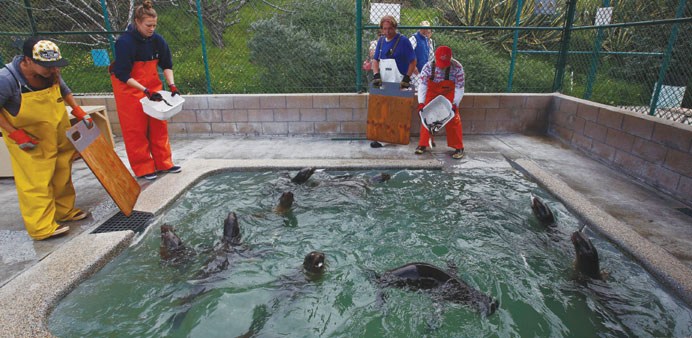By Amy Hubbard/Los Angeles Times/TNS
People in Marina del Rey, Californa, were surprised when a sea lion pup wandered into their apartment complex.
They named him Walter.
But getting help for Walter when he was spotted last week wasn’t easy. He’s just one sick pup among many ailing sea lions overwhelming marine mammal centres in California. Nearly 1,000 have washed ashore so far this year.
Emaciated and dehydrated sea lions, mostly pups about eight months old, have been admitted in record numbers to facilities up and down the California coast. It’s the third straight year of record strandings in the state.
More than 550 sea lions were being treated statewide as of February 18, according to National Oceanic and Atmospheric Administration Fisheries.
Rescuers are swamped.
Peter Wallerstein of Marine Animal Rescue works in much of Los Angeles County. He said he received calls about Walter before the young sea lion wandered into the complex. But as long as the pup was out of the way of people, he was on the back burner for rescue.
“But then this lady called me and said he was up in the parking lot. So I responded immediately because I knew it would be bad for him,” Wallerstein said.
There are so many strandings right now we cannot possibly pick up all the pups,” he said. “People just don’t seem to understand.”
Wallerstein’s two-person rescue team receives two dozen or more calls a day. He said he’d been rescuing marine mammals for 29 years and “for January and February, it’s the highest number of rescues I’ve ever seen.”
The same day Marina del Rey residents called about Walter, Roxanne McCann was walking along Las Flores Beach in Malibu when she spotted a thin sea lion pup on the shore.
“The poor little thing looked like it was struggling,” she said. “Everybody thinks it’s a cute story. People don’t understand that they’re not well.”
A neighbour’s call to a rescue hotline didn’t produce quick results. The neighbor later received a message saying there would be no action that day, McCann said.
California Wildlife performs marine mammal rescues in the Malibu area. A recording at the emergency line cautions that the “extreme high call volume” means animals may not be rescued on the day they’re spotted. “We also may not be able to return every phone call of a reported marine mammal.”
Earlier this month, researchers from NOAA’s National Marine Mammal Laboratory visited sea lion rookeries on the Channel Islands, where most of America’s sea lions breed, in a search for clues to the high number of strandings.
They measured and weighed pups and found them to be considerably underweight, with an average growth rate that was the lowest they had seen since they began monitoring in the early 1990s.
The pups’ weight was similar to that in 2013, the year of an “unusual mortality event” for sea lions, a phenomenon characterised by an unexpected number of strandings and significant die-off of a marine mammal population.
In 2013, the Marine Mammal Care Center in San Pedro was treating two to three times as many California sea lions as usual. David Bard, operations director, said that in the first two months of this year, the numbers are double what they were at the beginning of 2013.
Wallerstein remembers doing 25 rescues in the first two months of 2013. So far this year, he has rescued 117 marine mammals.
Scientists thought 2013 was an anomaly, said Shawn Johnson, director of veterinary services at the Marine Mammal Center in Sausalito.
“But then it happened again last year, and now it’s happening again,” he said.
Scientists are awaiting more data from the research on the Channel Islands, but NOAA Fisheries said higher-than-average sea surface temperatures along the California coast in fall 2014 may be a factor in the strandings.
The warmer water could have affected the availability of prey to the sea lions. Females sea lions might be spending more time and energy to obtain food, so pups are abandoned.
Another possibility is “the sea lion population is reaching carrying capacity,” Bard said.
California sea lions were exploited in the 19th and early 20th centuries for their hides and blubber and continued to be hunted for sport in some areas later in the 20th century. The Marine Mammal Protection Act of 1972 led to significant increases in the populations of marine mammals, Johnson said. The population is now 300,000, with a birth rate of about 50,000 a year.
The environment simply may not be able to support a larger sea lion population. According to the Marine Mammal Center, experts don’t believe the record strandings will affect California sea lion populations overall.
Still, “the current stranding crisis is concerning because it indicates a more complex occurrence in the ocean,” the centre said in a statement. “Our ocean is clearly under stress.”

Rescued sea lion pups are fed at Marine Mammal Care Centre at Fort MacArthur in San Pedro, California. Marine mammal experts say that hunger and cold


